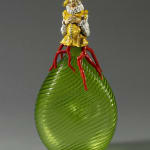

Polichinelle by (Jean-Louis) Ernest Meissonier.
P337.The Wallace Collection, London
Kevin Coates
width: 140 mm
The first day of Carnival in Venice seems an appropriate time and place for me to write about my response to Meissonier’s mischievous Polichinelle. He stands, hands clasped over his padded paunch, in furry Breton clogs (to which I will return later), with breeches, knee-bows, and stockinged legs apart, giving him the hooved and shaggy caprine stance of a wily old satyr. He is, of course, by origin not Polichinelle but Pulcinella, the lascivious reprobate of Italian Commedia dell’Arte and forefather of Judy’s ill-fated, wife-beating husband, Punch.
But Meissonier’s wonderful character study is colourful in more than one sense – for undoubtedly it is the vibrant Italianate palette which first commands the attention – since beyond its pigmental tints also lies the ‘colour’ of its circumstance. In fact, it was painted not just for the boudoir, but on the boudoir: to be precise, on a panel of its door. Both door and boudoir were those of Gauthier’s La Présidente – the Grand Courtesan Apollonie Sabatier (1822-1890) who held court – in the form of intellectual and artistic salons – which, in addition to Gautier, also hosted Baudelaire (who dedicated nine of his Fleurs du Mal to her), Flaubert, Manet, Dumas (senior), de Musset, of course Meissonnier – and Richard Wallace (1818-1890) himself. We are reminded in passing of the “five o’clocks” and the evening meetings of “the loyal clan” of Proust’s Madame Verdurin, but in this case the hostess-hub commanded her courtiers through what must have been a considerable personal charm and urbanity. Meissonnier – that painter of small, jewel-like, panels of which there are over a dozen to be found in the Wallace Collection – painted Madame Sabatier in 1853, as the most commanding figure of his compositional group À l’hombre des bosquets chante un jeune poète – The Recital, P326, where she stands in a pink 16th C. costume. The artist’s letters to her are gallant and courtly, cast in the polite vous and, on occasion, even the third person. And yet the message he left in 1860, painted for her upon a door in her apartment, was the disarming leer of the lecherous Polichinelle. I am sure that this, and Meissonier’s other versions, are portrait representations, for this is certainly an individual with a palpable, and living, identity; even his footwear of Breton clogs are highly individual – although Manet, a fellow ‘subject’ of Apollonie’s, also depicted Polichinelle thus shod, so perhaps we are seeing a particular contemporary performer who had subverted a form of clog-dancing to form part of his routine. My polyglot wife has suggested that there might also be an element of jeu de mots (or calembour) here on Apollonie’s surname, ‘Sabatier’, and ‘sabots’ or ‘sabotier’. Footwear aside, he did not stand long in his furry clogs at the Sabatier portal, however, for he was sawn from his door the following year (with the artist’s retouching care), to be sold as part of La Présidente’s art-collection, where it raised a considerable 13,000 francs from the pocket of Lord Hertford, who in this may have been guided by his son, Richard Wallace, a rumoured recipient of her favours.
I have borrowed Meissonier’s worldly Polichinelle, but returned him to his Italian stage, being unable to resist an Italian pun found in the word fiasco (in English, a dangerous concept) but which in Italian describes both a theatrical flop, and a particular form of glass bottle or flask (since the one often follows the other!). This was, in part, suggested by the contented, somewhat final, gesture of satiety with which he has folded his hands across his embonpoint, all but echoing the phrase of his English kinsman – “that’s the way to do it!”.
So for me, he now guards the contents of a flask, or decanter, of blown and reeded Venetian glass, the colour of Meissonier’s background (theatrical?) drapes. His damask costume, modelled in the round omitting what might have been a hunch-back, I have remade in part-gilded and patinated silver (he unscrews at the waist to open and close the decanter), but the dangerous red of his baggy haunches I have rendered in overlaying branches of coral: a charm against inebriation.
Although not intended as a ‘punch’-line, I have to voice the sorely begged question: on which side of the door did Meissonier paint his Polichinelle – is he Guardian, or Voyeur?

